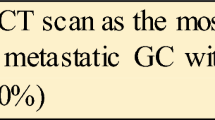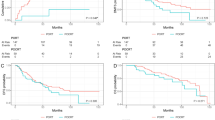Abstract
The aim of this study was to review the surgical and clinical outcomes of intrathoracic and mediastinal surgical cytoreduction in stage IV epithelial ovarian cancer (EOC). Relevant articles were identified from MEDLINE and EMBASE. Only analyses or reports that described actual intrathoracic cytoreduction via pleurectomy and/or resection of cardiophrenic/mediastinal lymph nodes were included. Imaging articles that merely described thoracic tumor patterns were excluded. A total of nine studies were identified, the oldest originating in 2007. Procedures described were transdiaphragmatic resection of cardiophrenic lymph nodes and pleural disease (n = 5) and video-assisted thoracoscopic and mediastinal tumorectomies including pleurectomy (n = 4). The number of operated patients ranged between 1 and 30 with complete cytoreduction rates ranging between 68 and 100%. No surgical deaths directly related to the thoracic cytoreduction were reported and only one patient (1/30) experienced a postoperative complication in terms of a pneumothorax. None of the studies presented a direct comparison of survival to patients with thoracic disease who did not undergo thoracic cytoreduction, and therefore the survival benefit of thoracic cytoreduction could not be quantified. In conclusion, thoracic cytoreduction in advanced EOC seems feasible and with acceptable morbidity while offering a better understanding of the extent of disease and hence allowing the tailoring of intraabdominal resections. Nevertheless, its direct impact on patients’ survival by a potential overruling of a more adverse tumor biology remains to be established in larger-scale prospective and ideally randomized trials.
Similar content being viewed by others
References
Munnell, EW. The changing prognosis and treatment in cancer of the ovary: a report of 235 patients with primary ovarian carcinoma. Am J Obstet Gynecol. 1968;100:790–805.
Chang SJ, Bristow RE. Evolution of surgical treatment paradigms for advanced-stage ovarian cancer: redefining “optimal” residual disease. Gynecol Oncol. 2012;125(2):483–92.
Chi DS, Bristow RE, Armstrong DK, Karlan BY. Is the easier way ever the better way? J Clin Oncol. 2011;29:4073–5.
Du Bois A, Quinn M, Thigpen T, Vermorken J, Avall-Lundqvist E, Bookman M, et al; Gynecologic Cancer Intergroup; AGO-OVAR; ANZGOG; EORTC; GEICO; GINECO; GOG; JGOG; MRC/NCRI; NCIC-CTG; NCI-US; NSGO; RTOG; SGCTG; IGCS; Organizational team of the two prior International OCCC. 2004 consensus statements on the management of ovarian cancer: final document of the 3rd International Gynecologic Cancer Intergroup Ovarian Cancer Consensus Conference (GCIG OCCC 2004). Ann Oncol. 2005;16(Suppl 8):viii7–viii12.
Chi DS, Franklin CC, Levine DA, et al. Improved optimal cytoreduction rates for stages IIIC and IV epithelial ovarian, fallopian tube, and primary peritoneal cancer: a change in surgical approach. Gynecol Oncol. 2004;94:650–4.
Du Bois A, Reuss A, Pujade-Lauraine E, Harter P, Ray-Coquard I, Pfisterer J. Role of surgical outcome as prognostic factor in advanced epithelial ovarian cancer: a combined exploratory analysis of 3 prospectively randomized phase 3 multicenter trials: by the Arbeitsgemeinschaft Gynaekologische Onkologie Studiengruppe Ovarialkarzinom (AGO-OVAR) and the Groupe d’Investigateurs Nationaux Pour les Etudes des Cancers de l’Ovaire (GINECO). Cancer. 2009;115:1234–44.
Lim MD, et al. Pathological diagnosis and cytoreduction of cardiophrenic lymph node and pleural metastasis in ovarian cancer patients using VATS. Ann Surg Oncol. 2009;16:1990–6.
Juretzka MM, et al. The impact of VATS in patients with suspected advanced ovarian malignancies and pleural effusions. Gynecol Oncol. 2007;104:670–4.
Ki KD, et al. VATS for recurrent ovarian cancer with a metastatic mediastinal mass. Onkologie. 2009;32:274–6.
Ragusa M, et al. Isolated cardiophrenic angle node metastasis from ovarian primary. Report of two cases. J Cardiothorac Surg. 2011;6:1.
Yoo HJ, et al. Transabdominal cardiophrenic lymph node dissection (CPLND) via incised diaphragm replace conventional VATS for cytoreductive surgery in advanced ovarian cancer. Gynecol Oncol. 2013;129:341–5.
Prader S, et al. Surgical management of cardiophrenic lymph nodes in patients with advanced ovarian cancer. Gynecol Oncol. 2016;141:271–5.
LaFargue CJ, et al. Short-term morbidity in transdiaphragmatic cardiophrenic lymph node resection for advanced-stage gynecologic cancer. Gynecol Oncol Rep. 2016;17:33–7.
LaFargue CJ, et al. Transdiaphragmatic cardiophrenic lymph node dissection in advanced-stage gynecologic cancer. Gynecol Oncol. 2015;139:178–207.
Garbi, et al. Feasibility of transabdominal cardiophrenic lymphnode dissection in advanced ovarian cancer: initial experience at a tertiary center. Int J Gynecol Cancer. 2017;27:1268–73.
Chi DS, Zivanovic O, Levinson KL, Kolev V, Huh J, Dottino J, et al. The incidence of major complications after the performance of extensive upper abdominal surgical procedures during primary cytoreduction of advanced ovarian, tubal, and peritoneal carcinomas. Gynecol Oncol. 2010;119:38–42. Epub 6 July 2010.
Diaz JP, et al. VATS evaluation of pleural effusions in patients with newly diagnosed advanced ovarian cancer can influence the primary management choice for these patients. Gynecol Oncol. 2010;116:483–8.
Ducie JA, et al. An analysis of the survival outcomes of video-assisted thoracic surgery in the primary management of patients with advanced ovarian, tubal, and peritoneal cancer. Gynecol Oncol. 2014;133:103.
Klar M, et al. Video-assisted thoracic surgery (VATS) evaluation of intrathoracic disease in patients with FIGO III and IV stage ovarian cancer. Gynecol Oncol. 2012;126:397–402.
DiGuilmi J, et al. Role of VATS in advanced ovarian cancer: a literature review. Int J Gynecol Cancer. 2016;26:801–6.
Disclosure
The authors declare that there are no conflicts of interest.
Author information
Authors and Affiliations
Corresponding author
Rights and permissions
About this article
Cite this article
Nasser, S., Kyrgiou, M., Krell, J. et al. A Review of Thoracic and Mediastinal Cytoreductive Techniques in Advanced Ovarian Cancer: Extending the Boundaries. Ann Surg Oncol 24, 3700–3705 (2017). https://doi.org/10.1245/s10434-017-6051-8
Received:
Published:
Issue Date:
DOI: https://doi.org/10.1245/s10434-017-6051-8




